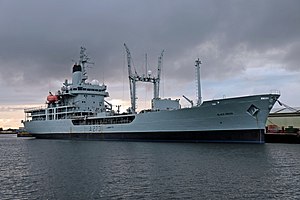RFA Black Rover
This article needs additional citations for verification. (September 2014) |
 RFA Black Rover at West Float, Birkenhead, in May 2016
| |
| History | |
|---|---|
| Name | RFA Black Rover |
| Operator | Royal Fleet Auxiliary |
| Builder | Swan Hunter, Tyne and Wear, United Kingdom |
| Launched | 30 October 1973 |
| Commissioned | 23 August 1974 |
| Identification | Pennant number: A273 |
| Fate | active in service |
| General characteristics | |
| Class and type | Template:Sclass- |
| Displacement |
|
| Length | Template:Rover class tanker length |
| Beam | Template:Rover class tanker beam |
| Draught | Template:Rover class tanker draught |
| Propulsion | Template:Rover class tanker propulsion |
| Speed | Template:Rover class tanker speed |
| Range | Template:Rover class tanker range |
| Boats & landing craft carried | 2 x Avon searider |
| Capacity | Template:Rover class tanker capacity |
| Complement | Template:Rover class tanker complement |
| Sensors and processing systems | Template:Rover class tanker sensors |
| Electronic warfare & decoys | Template:Rover class tanker EW |
| Armament |
|
RFA Black Rover is a small fleet tanker of the British Royal Fleet Auxiliary. She is designed to replenish ships underway at sea with fuel, fresh water, and stores in all weather conditions. She has a helicopter deck served by a stores lift and is capable of conducting helicopter replenishment. Displacing 11,500 tonnes, she is powered by twin diesels and has a ship's company of 56.
Service history
Black Rover was built by Swan Hunter, being launched in 1973. She was accepted into service in 1974 and is still on active deployment in 2014.
In 2000, Black Rover participated in Exercise Unified Spirit 2000 and Joint Task Force Exercise (JTFEX) 01-1. The combined exercise, which took place in the waters off the US East Coast and in the Caribbean, began on 9 October and included the USS Harry S. Truman Battle Group, USS Nassau Amphibious Ready Group and 14 NATO ships from Canada, France, Germany and the United Kingdom. Only two ships from the UK participated, one being Black Rover and the other the Type 42 destroyer Cardiff.
By February 2001, Black Rover set sail from Devonport Naval Base at the start of an 11-month deployment as the tanker assigned to the Atlantic patrol (south) task. Along with the destroyer Glasgow, she visited a number of ports as they sailed south and made their way to the coast of West Africa to support British forces in and around Sierra Leone. Later in 2001, the tanker crossed the Atlantic and headed even further south as she proceeded to the more traditional patrol area of the Falkland Islands. She returned home to the UK in December.
Black Rover was deployed from UK in June 2005 and its tasking included assisting with post-Tsunami reconstruction and participation in multi-national exercises in the Far East as the UK's component of the Five Power Defence Arrangement. On this deployment, she was commanded by Captain K Rimell.
Black Rover now has the role of Flag Officer Sea Training (FOST) tanker, and in September 2006 she hosted the RFA recruitment video film crew. Black Rover’s role as FOST tanker allowed the film makers to capture many of the RFA's capabilities. The busy nature of the FOST schedule allowed the film crew to experience a wide variety of exercises and evolutions during their time on board.
In 2013, Black Rover deployed to the Falkland Islands and South Georgia.[1]
Black Rover is scheduled to decommission in 2016.[2]
References
- ^ "The freezing Falkland Islands mid-winter dip. Brrrrr!". Royal Navy. 9 August 2013. Retrieved 22 June 2016.
- ^ "Defence Equipment: Decommissioning: Written question - 24277". parliament.uk. 26 January 2016. Retrieved 22 June 2016.

